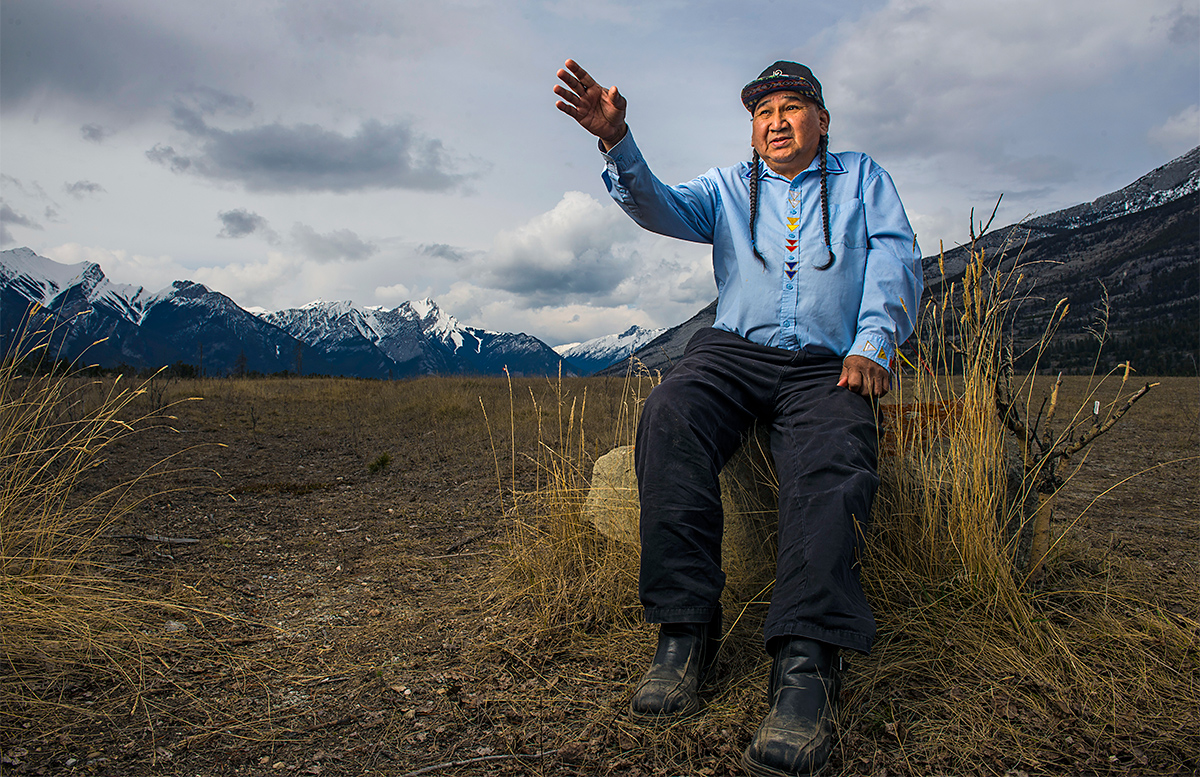Last August, the U of A installed The Sweetgrass Bear sculpture in Quad on North Campus. As part of the installation, nearly 60 university leaders and Indigenous community members participated in a pipe ceremony, led by Elder Jimmy O'Chiese, who told the crowd that we have to move forward together. President David Turpin responded by formally requesting O'Chiese's advice and support.
We, too, sought the elder's wisdom for this issue of New Trail. O'Chiese, who was raised in a traditional Foothills Ojibway family, is an elder, eminent scholar and instructor with Yellowhead Tribal College in Edmonton.
O'Chiese spent four hours speaking with the New Trail team to share some of his teachings about Indigenous culture and history. The experience was miles from classroom learning - story-based and, unlike western-style teaching, there was no easy bullet-point list of take-aways. As listeners, we were challenged to delve into the stories and each pull out our own meaning - a first-hand demonstration of teaching and learning in an Indigenous way.
Below, we share some of the themes O'Chiese touched on. While it is impossible to translate this experience of the spoken word to the page, we hope it helps readers share in the experience of learning from an elder.
Please note: While we aimed to stay as true as possible to the elder's words, by necessity the conversation has been edited for length and clarity.
The Spirit and Intent of the Treaties
"There's the constitution from England; there's the constitution that was here. If you ever look at the wampum belt - the first treaty that was negotiated - it says it right there, 'Side by side.' Not integration, side by side. Because we had our own education; we had our own laws; we had our own governance. We had our way of life, and we shared that with the Europeans that came here. And you must share that - work together. That's what that treaty was. Two laws, not only one side. Things will never work if only one side of the treaty is interpreted, if only one law is interpreted.
"That is why we need to interpret the treaty from our side. The Queen has her own laws and we didn't decide what those laws are. She [can decide] what's good for her people, right? What about the other way? No, somebody decided what's good for the Indian, what kind of Aboriginal laws they should have. We didn't decide that - we didn't even decide how this land is going to be divided up and separated. Divide the land also to divide people.
"When the settlers came, we were already here. We already had our own laws, which were later on outlawed by the Indian Act. The Canadian government decided what kind of rights we should have as the original peoples of this land. What I see, where we need to start, is to really understand the agreement. Why we are meant to co-exist here and what that treaty means - then the education that comes with it."
Why the Treaties Are Unfinished Business
"We shared the land with the Crown. And the Crown has its own constitution and, ourselves, we have our own constitution. Our constitution is part of the four directions, which is our relationship to the land. As long as the sun rises, as long as water flows, as long as grass grows, as long as there's Native people. Which is why the mark of the X was acceptable when we signed the treaty.
"You can see the X symbol on the original treaty documents. You can see that X symbol on the four directions, too, which is yet to be interpreted from our side, from what that X means based on the spirit and intent of treaties. Among Indigenous people, we were already using treaties. We knew about treaties. [Speaks in Anishinaabe.] So, if we don't understand each other today, [are the treaties] finished? It's unfinished business because our interpretation of treaty was outlawed, our education was outlawed, our governance was outlawed."
Education From Two Points of View
"To 'Indigenize education' is to put our native education into a box and teach from a European interpretation. It's another way of Europeans describing to us who we are according to their education. We shouldn't be trying to 'Indigenize education.' We should be recognizing our own Native education as it is, as it always has been, which is our own law - Creator's Law; some call it natural law. Creator gave us one air, one water, one world, one life. We were supposed to be learning from each other, according to the treaties; we were supposed to be teaching each other our education as it is. That's what it means to truly co-exist. Respecting each other's own education. Treaties are about agreeing to co-exist."
How Individuals Can Make a Difference
"Learn from one another. Learn about what it means to co-exist on this land now called Canada, but that we always called Turtle Island. Share with one another and learn what it truly means to share with one another. Education is part of the treaties. Learn about the education that we once had before Europeans arrived. Recognize the land-based education that was written on the land, and help bring it back the way it has always existed.
"We need to work together. That's how it was meant to be."

We at New Trail welcome your comments. Robust debate and criticism are encouraged, provided it is respectful. We reserve the right to reject comments, images or links that attack ethnicity, nationality, religion, gender or sexual orientation; that include offensive language, threats, spam; are fraudulent or defamatory; infringe on copyright or trademarks; and that just generally aren’t very nice. Discussion is monitored and violation of these guidelines will result in comments being disabled.